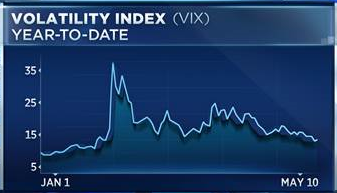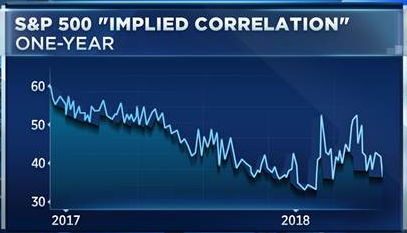Investors thrown off balance by swirling markets this year now face a new wrinkle: a sudden outbreak of normalcy.
This year stocks went from an unprecedented uphill sprint in January to a nasty stumble in February, followed by months of flailing, disoriented struggle.
But in the past couple of weeks, stocks have stabilized as a rush of strong earnings provided support and investors made a tentative peace with somewhat higher interest rates.
This return to a sort of normalcy can be seen from a few different angles.
The Cboe Volatility Index on Wednesday closed below 14 for the first time since late January. While there is no special technical significance to a VIX of 14 or lower, it is below its long-term average and reflects a calmer, less agitated market no longer spurring traders to pay up heavily for downside protection.

Whether cause, effect or simply coincident indicator, when the VIX ticked below 14 at midday Wednesday, the S&P 500 lifted off for what would be nearly a 1 percent one-day gain as traders took it as a further sign that the recent index lows should hold for now.
The turmoil since early February has mostly been an equity-specific affair, as stock prices became dangerously stretched to the upside and so did valuations and investor overconfidence. Yet the jumpiness in stocks did send a mild flutter of concern through corporate-credit markets as well.
This chart of the risk spread in “junk” bonds – measuring the extra yield over Treasuries that investors demand to accept their higher risk of default – shows the spread rising in February. They are now virtually back to where they were near the start of the year, which is to say near the tightest (that is, strongest) readings of this entire economic cycle.

So long as the capital markets remain confident about the credit profile of Corporate America, it’s tough to see too much immediate damage done to the broad stock market.
So far in May, the market is also back to largely shrugging off what seem to be jarring headlines yet have little bearing on the long-term value of companies and cash flows.
When President Trump announced his decision to withdraw from the Iran-nuclear agreement Tuesday, the markets merely hesitated and then resumed a gentle uptrend. The various investigations and revelations about the president’s personal and political circle have been met with no discernible response.
And within the market, stocks and sectors are responding in their own way to news most relevant to them rather than the swinging around in unison as one monolithic blob.
This chart of “implied correlation” shows the degree to which stocks are moving purely together with the index or along their own path. The recent decline back toward levels of last year shows a break in the fever of “risk-on/risk-off” trading.

The character of the sector interplay is also a bit more “normal.” In recent days we’ve seen shades of the elegant-seeming rotation among stronger or weaker groups that kept the market in a balanced, measured uptrend last year. Technology, financials, industrials, transportation stocks and energy have lately been leaders, offset by the yield-centric defensive sectors including utilities and consumer staples.
All else being equal, that leadership profile shows a market comfortable with the underpinnings of the economy.
None of this is to say the market has worked through all its issues and is destined for a quick return to or beyond the old highs. This remains a fairly prolonged setback and the S&P 500 remains more than 5 percent from its January peak.
While the market has tried to come to terms with somewhat higher rates, $70 oil, a firmer U.S. dollar and a Fed determined to tighten policy steadily, any of these issues could cross a tripwire of concern before too long. And a “normal” market could still very well encounter the common summer storminess ahead of the mid-term elections.
Still, the steadier action and more logical interaction among various market segments indicates that investors no longer feel over-exposed to stocks, the crowd’s expectations have been reset lower and the fundamentals are acceptable at current valuations. At least for now.
Source: Investment Cnbc
After months of turbulence, markets and investors face a sudden outbreak of normalcy